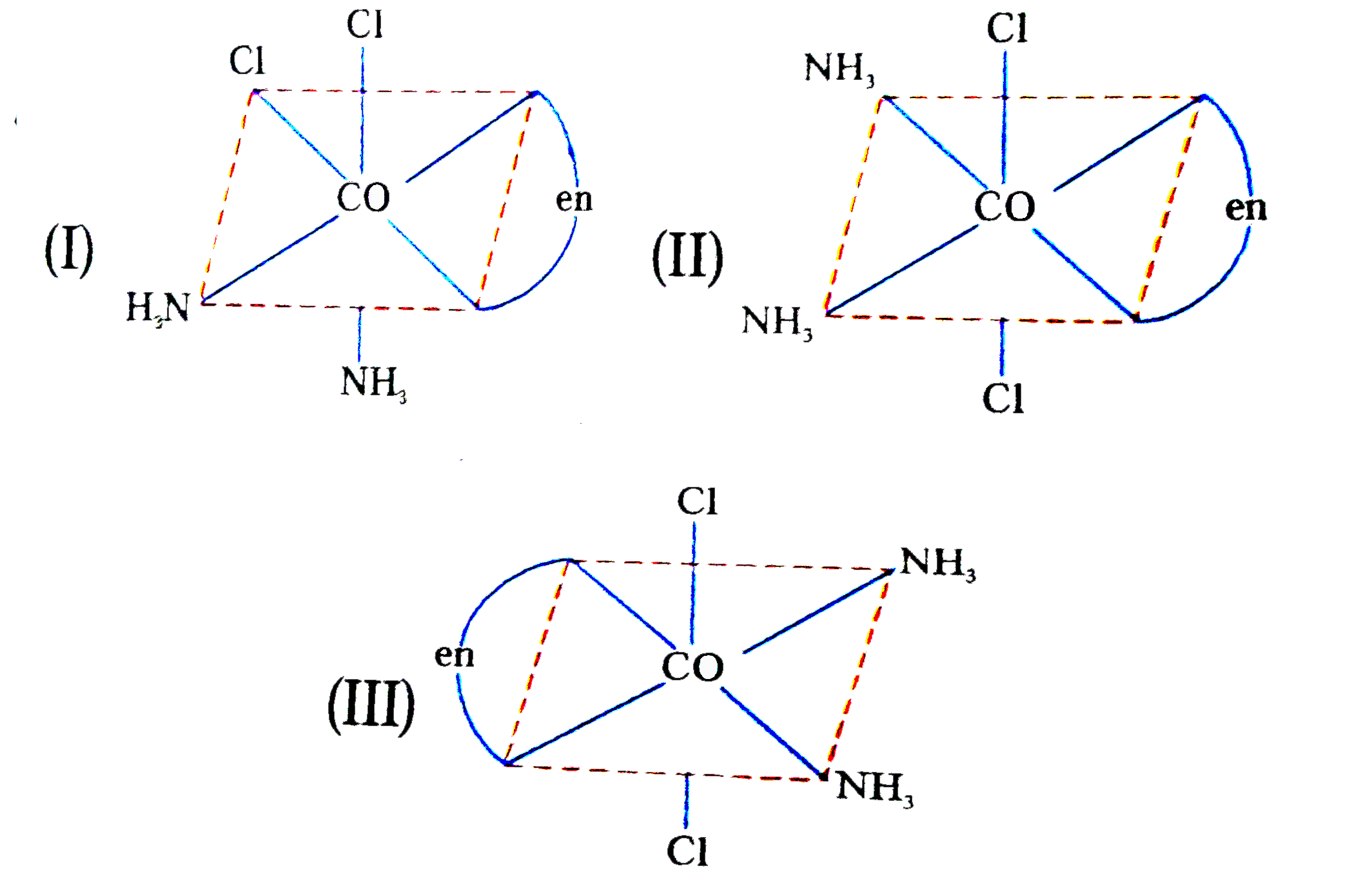Which of the following is true for the complex Co(NO2)(Cl)2.5NH3 (Co is in + 3 oxidation state)
It shows ionisation isomerism
It is inner orbital complex
It is diamagnetic
All
The correct Answer is:D
To determine which statements are true for the complex Co(NO2)(Cl)2⋅5NH3 where cobalt is in the +3 oxidation state, we can follow these steps:
Step 1: Identify the oxidation state of cobalt
The oxidation state of cobalt in the complex is given as +3. The nitrite ion (NO−2) has a charge of -1, and each chloride ion (Cl−) has a charge of -1. The ammonia (NH3) is a neutral ligand.
Step 2: Write the overall charge balance
The complex can be represented as:
Co3++2Cl−+5NH3+1NO−2
The total charge from the ligands is:
2(−1)+1(−1)=−2−1=−3
Thus, the overall charge is:
+3−3=0
This confirms the charge balance in the complex.
Step 3: Determine the coordination number
The coordination number is the total number of ligand donor atoms surrounding the central metal ion. In this case, we have:
- 5 ammonia ligands (each donating 1 pair of electrons)
- 1 nitrite ligand (donating 1 pair of electrons)
- 2 chloride ligands (each donating 1 pair of electrons)
Thus, the coordination number is:
5+1+2=8
Step 4: Identify the type of isomerism
The complex can exhibit linkage isomerism due to the presence of nitrite, which can coordinate through either nitrogen or oxygen. It can also show ionization isomerism because the chloride ions can be either inside or outside the coordination sphere.
Step 5: Determine if the complex is inner or outer orbital
For cobalt in the +3 oxidation state, the electronic configuration is:
Co3+:(Ar)3d6
In the presence of strong field ligands (like NH3 and NO−2), the electrons will pair up in the lower energy 3d orbitals. This results in a configuration of t62g and no unpaired electrons, indicating that the complex is diamagnetic.
Step 6: Determine the hybridization
With a coordination number of 6, the hybridization is d2sp3, indicating that it is an inner orbital complex.
Summary of Findings
1. Cobalt is in the +3 oxidation state.
2. The coordination number is 6.
3. The complex can exhibit linkage and ionization isomerism.
4. The complex is an inner orbital complex and is diamagnetic.
Conclusion
All statements provided in the options regarding the complex Co(NO2)(Cl)2⋅5NH3 are correct.
Answer
Option D: All of these.
The oxidation state of cobalt in the complex is given as +3. The nitrite ion (NO−2) has a charge of -1, and each chloride ion (Cl−) has a charge of -1. The ammonia (NH3) is a neutral ligand.
The complex can be represented as:
Co3++2Cl−+5NH3+1NO−2
The total charge from the ligands is:
2(−1)+1(−1)=−2−1=−3
Thus, the overall charge is:
+3−3=0
This confirms the charge balance in the complex.
The coordination number is the total number of ligand donor atoms surrounding the central metal ion. In this case, we have:
- 5 ammonia ligands (each donating 1 pair of electrons)
- 1 nitrite ligand (donating 1 pair of electrons)
- 2 chloride ligands (each donating 1 pair of electrons)
5+1+2=8
The complex can exhibit linkage isomerism due to the presence of nitrite, which can coordinate through either nitrogen or oxygen. It can also show ionization isomerism because the chloride ions can be either inside or outside the coordination sphere.
For cobalt in the +3 oxidation state, the electronic configuration is:
Co3+:(Ar)3d6
In the presence of strong field ligands (like NH3 and NO−2), the electrons will pair up in the lower energy 3d orbitals. This results in a configuration of t62g and no unpaired electrons, indicating that the complex is diamagnetic.
With a coordination number of 6, the hybridization is d2sp3, indicating that it is an inner orbital complex.
1. Cobalt is in the +3 oxidation state.
2. The coordination number is 6.
3. The complex can exhibit linkage and ionization isomerism.
4. The complex is an inner orbital complex and is diamagnetic.
All statements provided in the options regarding the complex Co(NO2)(Cl)2⋅5NH3 are correct.
Option D: All of these.
Topper's Solved these Questions
- INORGANIC CHEMISTRYBOOK - ALLENCHAPTER - INORGANIC CHEMISTRYEXERCISE - COORDINATION COMPOUNDS & d-BLOCK COMPOUNDS (MATCH THE COLUMN)
2 Videos
- INORGANIC CHEMISTRYBOOK - ALLENCHAPTER - INORGANIC CHEMISTRYEXERCISE - p-BLOCK ELEMENT
80 Videos
- INORGANIC CHEMISTRYBOOK - ALLENCHAPTER - INORGANIC CHEMISTRYEXERCISE - CHEMICAL BONDING
119 Videos
- HYDROGENBOOK - ALLENCHAPTER - HYDROGENEXERCISE - EXERCISE-5
17 Videos
- Ionic EquilibriumBOOK - ALLENCHAPTER - Ionic EquilibriumEXERCISE - All Questions
37 Videos
Similar Questions
Knowledge Check
The oxidation of central atom in the complex [Co(NH3)4CINO2] is
A+2B+3C+1DzeroThe charges x and y on the following ions are
(i)[Co(NH3)2Cl4]x (ii)[Fe(CN)6]y
(Oxidation state of Co is +3 and Fe is + 2 in their respective complexes.)Ax = + 1 , y = - 1Bx = -1 , y = + 3Cx = -1 , y = -4Dx = -2 , y = -3
The number of geometrical isomers of the complex [Co(NO2)3(NH3)3] is
View SolutionThe IUPAC name of the complex [Co(NO2)(NH3)5]Cl2 is
View SolutionThe hybridization of the complex [CrCl2(NO2)2(NH3)2]− is:
View Solution[Co(NH3)5NO2]SO4 shows
View SolutionConsider the following arrnagements of the octahedral complex ion [Co(NH3)4Cl2]+.

Which of the following statements is false?
View SolutionThree arrangements are shown for the complex [Co(en)(NH3)2Cl2]+ pick up the wrong statement.

View Solution
